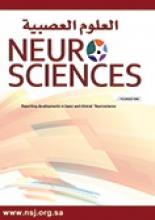To the Editor
I have read with interest the article Awareness of stroke among patients attending primary healthcare services in Abha, Southwestern Saudi Arabia, by Alhazzani et al published in the Neurosciences.1 Such studies are commendable as they contribute to the establishment of appropriate public health policy.
Stroke, although a major public health issue across the globe is not as widely publicized as some other health conditions resulting in suboptimal public awareness. A prior study from primary healthcare centers of Gulf Cooperation Council (GCC) countries had also shown very low level of knowledge about stroke in public.2 This study showed that only 29% of respondents had heard about stroke.2 A later study from Riyadh, Saudi Arabia showed 64% of the respondents were able to define stroke.3 Younger age was consistently linked to better knowledge, however, the impact of gender and educational level varied in these studies.1-3
In the study by Alhazzani et al1 22% of respondents were able to identify >4 stroke risk factors,1 which is very similar to another study in which 21.7% respondents were able to identify ≥5 stroke risk factors.3 A very recent study showed that 59.3% were able to identify 5 or more risk factors, whereas 68.3% were able to identify at least 3 warning signs of stroke.4 In this study,4 70% of the respondents wanted to call ambulance in response to stroke, which is much higher than previous survey.1 This may be an improvement in awareness over time, however, differences may be attributed to a much younger age of respondents (mean age 27.7 years) and a female preponderance of respondents.4
In the study by Alhazzani et al1 although the overall awareness about stroke was unsatisfactory, it is of interest that media and healthcare providers were important determinants of improving knowledge about stroke symptoms and risk factors. However, when media was the source of information, the response to stroke was often inappropriate. These findings may suggest that all the content of information available on media may not be correct.
Saudi population is one of the largest users of social media, hence stroke awareness campaigns through social media may have significant impact on stroke education among masses, with appropriate and scientifically validated information. This needs to be tested in future studies. Saudi Stroke Society can play a role in dissemination of necessary and authenticated information about stroke to public.
Reply from the Author
The authors wish to acknowledge the interest of Dr. Ismail Khatri in our published article. Indeed, recent literature review shows improvement of stroke awareness among Saudi Population over time.4 However, our results may be different from this recent article due to differences in the studied populations. Yet, our results focused on importance of formulating an accurate source of information through the media. Perhaps the bottom line of our results shows the importance of raising awareness and guidance for future awareness campaign strategies (through media and health care workers) in collaboration with concerned scientific societies. Creating a robust source of information on the web for the Saudi population in their own language may enhance this approach. Primary health care settings can be a good starting point to disseminate the proper knowledge among the public in this respect. Our ultimate objective is to reduce the burden of stroke through translating evidence into policy.5
Ahmed A. Mahfouz,
Department of Family and Community Medicine, College of Medicine, King Khalid University, Abha, Kingdom of Saudi Arabia,
- Copyright: © Neurosciences
Neurosciences is an Open Access journal and articles published are distributed under the terms of the Creative Commons Attribution-NonCommercial License (CC BY-NC). Readers may copy, distribute, and display the work for non-commercial purposes with the proper citation of the original work.






